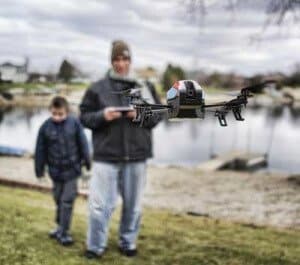With the public’s ever-increasing negative perception of drones, safe and responsible flying is something every pilot should be doing. Although many variables factor into each flight, there are several steps you can take to guarantee every flight you perform is completed as safe as possible.
Numerous safety features are being added to new drones as they come out, such as GPS stabilization, obstacle avoidance, and even geo-fencing that prevents flying in restricted airspace, but the pilots actions ultimately determine whether the drone poses a risk while it’s in the air.
One should always perform a preflight check before taking off. The specific steps will vary among different models, however the basics all remain the same. The first thing to verify is if the area you are in is suitable for taking off. Check if where you’re going to fly is within a no-fly zone, or within five miles of an airport. If it is, ask for permission to fly from the airport or organization placing a no-fly zone there several days prior to takeoff with specifics of your flight plan, and where you intend to go.
 Following verifying permission to fly in the area, research the weather for the day you intend to fly on. Make sure there is no forecasted rain, snow, or fog, and there is no more than a moderate amount of wind.
Following verifying permission to fly in the area, research the weather for the day you intend to fly on. Make sure there is no forecasted rain, snow, or fog, and there is no more than a moderate amount of wind.
Once the conditions and area have been reviewed, begin to find an open area and set up your drone. Once it is all set, ensure that the battery is properly connected and the propellers are firmly screwed on. The propellers shouldn’t have any nicks or damage. Next, inspect the drone for any cracks or loose parts. See that the battery of the controller and the drone are fully charged. Once this is complete, power on the controller, then turn on drone.
When the camera starts transmitting, it’s essential to check that it has a strong signal, as well as the controller. Proceed to take-off, hover for a few seconds and test that the controls are responsive. Continue with your planned flight, making sure to keep the drone in your line of sight at all times. Be aware of any possible obstacles to avoid such as power lines or trees, and be gentle on the controls.
Once you’re ready to land, find a flat area near where you took off and ease the drone to the ground, turning off the motors when you get there. Always power the drone off before turning off controller.
Remember, while you are flying your actions represent the entirety of drone pilots, so always be mindful and respectful of others. Now that you have the tools for a safe, successful flight every time, you are responsible for showing the public how attentive of safety the majority of drone pilots are. Have fun flying!
One Comment on “Steps to a Safe, Successful Drone Flight”
Good information, very sound advice.